Dr.Teruo Higa’s
Living A Dream
- 2025
- Sep:#209 The Widespread Use of EM in Ecuador
- Sep:#208 The Widespread Use of EM in Chile
- Jul:#207 Peru, where EM has taken root throughout the country
- May:#206 EM Application Technology in Paraguay Begins to Evolve into Advanced Circular Agriculture
- May:#205 Practical Application of Soil Disinfectant-Free Cultivation Using EM Technology
- Apr:#204 How EM Use Has Spread Throughout the Philippines
- Mar:#203 How to Use EM to Fundamentally Solve the Problem of Agricultural Residue Burning
- Feb:#202 The Spread of EM technology in Germany
- Jan:#201 The 2nd Ichiro Masaki Memorial Universal Village EM International Conference
- Jan:#200 Cleanup of the Ala Wai Canal in Hawaii, where social bonds are strengthened using EM
- 2024
- Nov:#199 EM trials in India with bananas, tomatoes, and pomegranates
- Oct:#198 The Steadily Evolving EM Nature Farming Method at the Blue Sky Palace - Part 8
- Sep:#197 The Steadily Evolving EM Nature Farming Method at the Blue Sky Palace - Part 7
- Aug:#196 The Steadily Evolving EM Nature Farming Method at the Blue Sky Palace - Part 6
- Jul:#195 The Steadily Evolving EM Nature Farming Method at the Blue Sky Palace - Part 5
- Jun:#194 Steadily Evolving EM Nature Farming Method at the Blue Sky Palace - Part 4
- May:#193 Steadily Evolving EM Nature Farming Method at the Blue Sky Palace - Part 3
- May:#192 Steadily Evolving EM Nature Farming Method at the Blue Sky Palace - Part 2
- Apr:#191 Steadily Evolving EM Nature Farming Method at the Blue Sky Palace
- Mar:#190 Quantum Mechanical Effects of EM Gravitron Charcoal
- Mar:#189 The barrier space in Okinawa (Ryukyu Islands) has risen to another dimension
- Jan:#188 Sixty Days after Typhoon No.6
- 2023
- Oct:#187 Supermassive Typhoon No.6 and Subsequent Typhoon No. 11
- Sep:#186 Massive Typhoon No.6 that swallowed the Ryukyu Islands Graviton barrier
- Sep:#185 August 8th is World “EM Mudball Day”
- Aug:#184 A disease-free life depends on the health of the intestinal microbiome.
- Jul:#183 Trial and Error at the Blue-Sky Palace, Part 3
- Jun:#182 Trial and Error at the Blue-Sky Palace, Part 2
- Apr:#181 Trial and Error at the Blue-Sky Palace
- Mar:#180 Ala Wai Canal Cleanup Project in Waikiki, Hawaii
- Feb:#179 High-Yield, High-Quality Rice Production Using EM
- Feb:#178 The Progress the "Soil Preparation Workshop" of the Oishi 3-chan Club (Part 2)
- Jan:#177 Organic Farming Instructional Manual Using EM
- 2022
- Nov:#176 The Typhoon Situation in Okinawa in 2022
- Sep:#175 Third-Party Verification of the Graviton barrier in Okinawa Part-2
- Sep:#174 Third-Party Verification of the Graviton barrier in Okinawa
- Aug:#173 Ecosystem Changes Observed in Okinawa in 2021 Part-5
- Jun:#172 Ecosystem Changes Observed in Okinawa in 2021 Part-4
- May:#171 Ecosystem Changes Observed in Okinawa in 2021 Part-3
- Apr:#170 Ecosystem Changes Observed in Okinawa in 2021 Part-2
- Mar:#169 Koizumi Farm in Kamakura Continues to Evolve
- Feb:#168 Ecosystem Changes Observed in Okinawa in 2021 Part-1
- 2021
- Dec:#167 Enjoying EM Technology While Enriching the Local Ecosystem
- Nov:#166 A Case Study of the Use of EM in a Next Generation Free School in Tune with the Cycles of Nature
- Oct:#165 Typhoon conditions and flowers in Okinawa from August to October
- Sep:#164 Re-learning the origins of river purification using EM Cleaning up the Dairyuji River in Senami (Murakami City, Niigata Prefecture)
- Aug:#163 Measures Against Natural Disasters and Re-learning the Starting Point of EM
- Jul:#162 Summary of FFC (Foods for Children) Okinawa Forum 2021
- Jun:#161 Restoring the Vigor of an Old Tree and Purifying the Environment with EM Technology That Even an Amateur Can Do
- May:#160 The Public is Beginning to Recognize the Use of EM Smokeless Carbonizers
- Apr:#159 EM Hado (EM Graviton) that exerts quantum superposition effect over time
- Mar:#158 Virus-free Okinawan Plants Through Use of an EM Graviton Barrier
- Jan:#157 Enjoyable Farming for Self-Sufficiency that Even Amateurs Can Do
- 2020
- Dec:#156 EM quantum energy effect occurring in Okinawa
- Nov:#155 Implementing EM graviton farming as a flood countermeasure for apple orchards
- Oct:#154 The Latest Book on the Practical Uses of EM "You Are the One Who Draws Out the Power of Microorganisms," by Chizuko Nomoto
- Sep:#153 Application of EM technology to long periods of rain, lack of sunshine, storms, heavy rains, etc.
- Aug:#152 EM application in Kitanakagusuku village plant waste recycling yard
- Jul:#151 Natural Disaster Countermeasures Using EM Technology: Part 2
- Jul:#150 Natural Disaster Countermeasures Using EM Technology
- May:#149 How to make your home and workplace an energy spot by living a complete EM lifestyle: creating the ultimate source of health and environmental purification
- Apr:#148 EM, Viruses and the Pandemic
- Apr:#147 New agriculture applying quantum mechanics Part 2
- Apr:#146 New agriculture applying quantum mechanics
- Apr:#145 Wonderful EM Miracle
- 2019
- Nov:#144 The movie “Revival II” and the reality of Fukushima
- Oct:#143 Boundary dome and foliar spraying of EM・X GOLD and EM 3
- Oct:#142 Kirakira (Sparkling) Summer Vegetable Festa in 2019
- Aug:#141 Excessive salt inevitably causes salt damage
- Jul:#140 Diverse applications of charcoal Part 3
- Jun:#139 Diverse applications of charcoal Part 2
- Jun:#138 Diverse applications of charcoal
- Jun:#137 Purification power of salt
- May:#136 The degree of soil contamination is a reflection of the microflora
- May:#135 Definitive use of EM barriers to deal with typhoons
- May:#134 Implementing authentic Nature Farming
- May:#133 How to enhance healthy Hado (wave energy) by EM
- May:#132 Eating Dirt (Soil)
- May:#131 Hado (Wave energy) involved in health
- May:#130 Reaffirming EM technology to realize the essence of agriculture
- May:#129 The 2nd EM Producer Networking Meeting
- Apr:#128 Understanding the application of seawater and salt in crop cultivation
- Apr:#127 Prevention of Disasters by EM Technology
- Mar:#126 Quantum overlay effective utilization of EM
- Jan:#125 EM Disaster Recovery Support Projects in 2017
- 2018
- 2017
- Aug:#121 Escape from conventional agricultural traps
- Jul:#120 Limitation and important caveats regarding utilization of salt
- Jun:#119 EM Technology to Break Through the Limits of Pesticide-Free Strawberries
- May:#118 Application of barriers using EM rectification force
- Apr:#117 The 1st EM Produce Growers' Networking Conference
- Mar:#116 Sumizo kun: The Ultimate Versatile Carbonization Equipment
- Feb:#115 How to make and use simple carbonized and rectified ash
- Jan:#114 Achievements of 2016
- 2016
- Dec:#113 Definitive Measures Against Typhoons
- Nov:#112 International Conference on Universal Village
- Oct:#111 90% of Your Body is Microbes
- Sep:#110 Disaster Countermeasures Using EM
- Aug:#109: Changes in the Natural Environment by EM Barrier Domes in Okinawa
- Jul:#108: Multi-purpose Utilization of Activated EM with Seawater and Salt
- Jun:#107: Marine Day, when EM Mudballs and Activated EM are Applied Throughout Japan
- May:#106: The Function of EM and Gravitational Waves–Part 3
- Apr:#105: The Function of EM and Gravitational Waves–Part 2
- Feb:#104: The Function of EM and Gravitational Waves
- Feb:#103: The Importance of Phototrophic Bacteria in EM
- 2015
- Dec:#102: Results of Environmental Forum "Utsukushima EM Paradise" 2015
- Nov:#101: Environmental Forum "Utsukushima EM Paradise" 2015
- Oct:#100: A New Phase of Limit Breakthrough Using EM
- Sep:#99: A New Phase of Limit Breakthrough through EM
- Aug:#98: The Tokyo Bay Area Began Creating a Truly Livable Hometown
- Jul:#97: Rectifying Effects of EM
- Jun:#96: Lake Suwa Sousei lecture
- May:#95: In Order to Further Ensure Limit Breakthrough
- Apr:#94: Theatrical Release of the Documentary Film SOSEI-Revival to Enlighten People on the New Possibilities of Microorganisms
- Mar:#93: What Underlies Limit Breakthrough (Part 2)
- Feb:#92: EM Functions to Break Through Limits
- Jan:#91: At the Start of 2015
- 2014
- Dec:#90: Looking Back at 2014
- Nov:#89: Shikoku EM FESTA 2014, Virtuous Circle Conference in Matsuyama, Ehime Prefecture
- Oct:#88: Using EM to Deal with Weather Disasters (Part 2)
- Sep:#87: Current Status of Radioactivity Measures Using EM in Fukushima
- Aug:#86: APNAN (Asia Pacific Natural Agriculture Network) 25th Anniversary Conference in 2014
- Jul:#85: Using EM to Deal with Weather Disasters
- Jun:#84: Substantial Improvement of Soil
- May:#83: The Energy Rectification Force of EM
- Apr:#82: The Annual 18th EM Technology Exchange Meeting and Tohoku Conference in Shichigahama
- Mar:#81: Salmon going upstream in Kitaura (Kasumigaura)
- Feb:#80: The Microbiome Again
- Jan:#79: Inauguration of the Federation of Diet Members Who Use and Apply Effective Microorganisms
- 2013
- Dec:#78: Receiving an Honorary Doctoral Degree from Rajamangala University of Technology in Thailand
- Nov:#77: The Use of EM in School Education in Bhutan
- Oct:#76: Well of Bonding
- Sep:#75: The Background to EM Not Being Employed by Public Institutions to Deal with Radiation
- Aug:#74: Dealing with Disaster: Using EM in Crisis Management
- Jul:#73: EM Events on Ocean Day
- Jun:#72: Using EM to Deal With Heat Stroke and Summer Heat Fatigue
- May:#71: An EM Model Town in Malaysia
- Apr:#70: Steps the Japanese Government is Taking to Deal with Radiation: Are They Really Safe?
- Mar:#69: EM Group Disaster Reconstruction Aid Project in Fukushima
- Feb:#68: EM and Microbiomes (Microbial Flora)
- Jan:#67: A Necessary Evil is Still Evil
- 2012
- Dec:#66: The 17th National EM Technology Exchange Conference / Hokkaido Conference in Sapporo
- Nov:#65: EM Forum 2012 in Okinawa and the Environmental Forum in Fukushima
- Oct:#64: 2012 EM Forum
- Sep:#63: A New Earth Saving Revolution
- Aug:#62: The Asahi Newspaper’s Misguided Reports About EM
- Jul:#61: Using EM in Radioactive Contamination Measures in Fukushima Prefecture
- Jun:#60: The Effects of Using EM to Inhibit the Absorption of Radioactivity as Confirmed in Fukushima
- May:#59: Recovery Support for the Great East Japan Earthquake
- Apr:#58: The Royal Kingdom of Thailand, in which EM Functions as a Set Government Policy
- Mar:#57: Report on the Measures Taken by Kingdom of Thailand Using EM to Deal with Polluted Water
- Feb:#56 EM™ as Part of National Policy in Thailand to Deal with Sanitation Issues Resulting from the Flood of 2011
- Jan:#55 The Law of Syntropy (Revitalization)
- 2011
- Dec:#54 EM Forum 2011
- Nov:#53 Shikoku EM Festa 2011- Zenjunkan no Wa (Virtuous Circle) Tokushima Conference in Naruto -
- Oct:#52 The Mystery of Interim Safety Values for Radioactive Material
- Sep:#51 Successful Radiation Countermeasures Using EM
- Aug:#50 Events on Sea Day in which EM Mud Balls are Thrown into the Water and Activated EM is Applied.
- May:#47 Dealing with the Damage Caused by the Eastern Japan Earthquake
- Apr:#46 Eastern Japan Earthquake
- Mar:#45 The 16th National EM Technology Hokuriku Conference in Fukui
- Feb:#44 More Thoughts on Avian Influenza and Foot-and-Mouth Disease
- Jan:#43 Happy New Year!
- 2010
- Dec:#42 Shikoku EM FESTA 2010・Zenjunkan no wa (Virtuous Circle) Fellowship Conference in Tobe, Ehime Prefecture
- Nov:#41 EM Forum 2010
- Oct:#40: My Thanks to the EM™ Volunteers Who Helped in the Fight Against Foot-and-Mouth Disease in Miyazaki Prefecture
- Sep:#39 International EM Mud Ball Day
- Jul:#37 Poland EM Forum 2010
- Jun:#36 EM Countermeasures Against Foot-and-Mouth Disease
- May:#35 Abnormal Weather
- Apr:#34 EM Activities in Thailand: Finding Solutions to the Challenges Facing the Nation
- Mar:#33 New Developments in the Evolution of EMTM in Thailand
- Feb:#32 Results Starting to Be Seen at the Mikasa Project
- Jan:#31 Towards an EM-Use Society
- 2009
- Dec:#30 EM Summit
- Nov:#29 The System in Penang State in Malaysia that Made the World EMTM Mudball Day a Success
- Oct:#28 The "World EM Mudball Day" in Malaysia
- Sep:#27 Validating EMTM Medicine: Case Study Reports from EM Users 2009. (Part 3)
- Sep:#26 Validating EMTM Medicine: Case Study Reports from EMTM Users 2009. (Part 2)
- Jul:#25 Validating EMTM Medicine: Case Study Reports from EMTM Users 2009. (Part 1)
- Jun:#24 Activities to Disseminate EM-Focused Nature Farming in China
- May:#23 Use of EMTM in Response to Swine Flu
- Apr:#22 Using EM to Solve Public Administrative Costs
- Mar:#21 Reaffirming the Versatility of EM
- Jan:#20 The Beginning of a New Era
- 2008
#182 Trial and Error at the Blue-Sky Palace, Part 2

The efforts made everyday at the Blue-Sky Palace have several aims: to make it easier to maximize the use of no-tillage, as well as smooth the way for continuous cultivation and ecological space and the ultimate creation of revitalizing space easier.
As I mentioned in the previous article, the idea is to utilize the atomic conversion power of EM to convert salt into fertilizer, and to continually manage the increase of EM DNA in the soil.
It is essential to treat any organic matter, including food waste, manure, etc., so that EM can increase, and to always return it to the soil. In conventional farming, we normally use EM when growing crops, but if we want an improvement in the ecological space, it is important to plant something in the entire area, including areas not devoted to crops, return organic matter to the soil, and continue to apply activated EM seawater solution. Doing this will enhance the atomic conversion power of the soil as a whole, and produce phenomenon that go far beyond what conventional wisdom would expect.
What we are currently working on is the permanent planting mass method. As shown in the photos, a 20-30 cm hole is dug, 100-150 g of salt and 500 ml of EM Gravitron Charcoal are placed in the hole, and 500 ml of activated EM solution is added on top, and 10-15 cm of soil is added back. Fruit and vegetable crops such as tomatoes, eggplants, and cucumbers are then planted on top of this. Lettuce and other vegetables should be planted at the base of the plants to fully utilize the space, as shown in Photo #8, “Lettuce and tomatoes on the left side of the entrance,” as shown in the previous article.
As I mentioned in the previous article, the idea is to utilize the atomic conversion power of EM to convert salt into fertilizer, and to continually manage the increase of EM DNA in the soil.
It is essential to treat any organic matter, including food waste, manure, etc., so that EM can increase, and to always return it to the soil. In conventional farming, we normally use EM when growing crops, but if we want an improvement in the ecological space, it is important to plant something in the entire area, including areas not devoted to crops, return organic matter to the soil, and continue to apply activated EM seawater solution. Doing this will enhance the atomic conversion power of the soil as a whole, and produce phenomenon that go far beyond what conventional wisdom would expect.
What we are currently working on is the permanent planting mass method. As shown in the photos, a 20-30 cm hole is dug, 100-150 g of salt and 500 ml of EM Gravitron Charcoal are placed in the hole, and 500 ml of activated EM solution is added on top, and 10-15 cm of soil is added back. Fruit and vegetable crops such as tomatoes, eggplants, and cucumbers are then planted on top of this. Lettuce and other vegetables should be planted at the base of the plants to fully utilize the space, as shown in Photo #8, “Lettuce and tomatoes on the left side of the entrance,” as shown in the previous article.
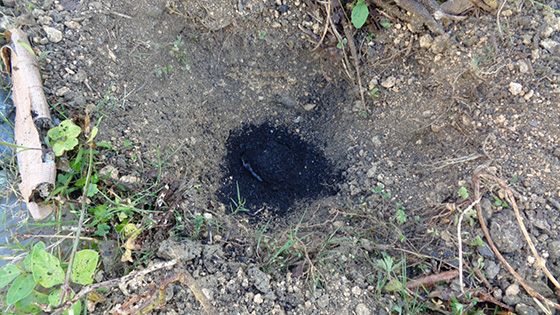
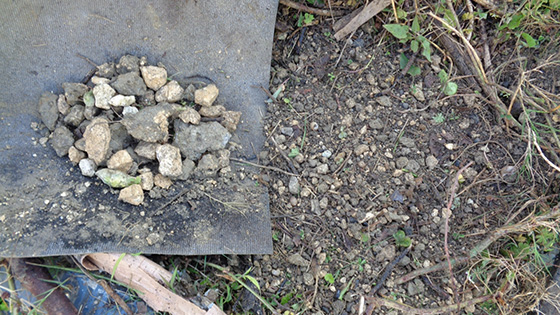
Right: Permanent planting mass method with soil returned. It is possible to plant even in such a stony soil.
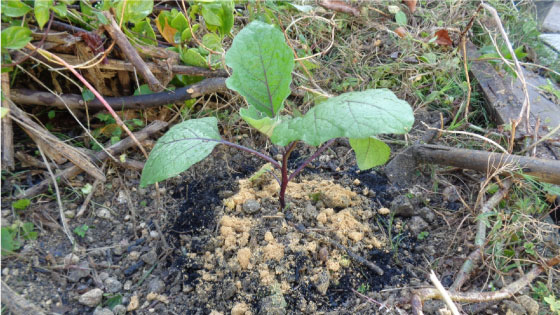
Permanent planting mass method
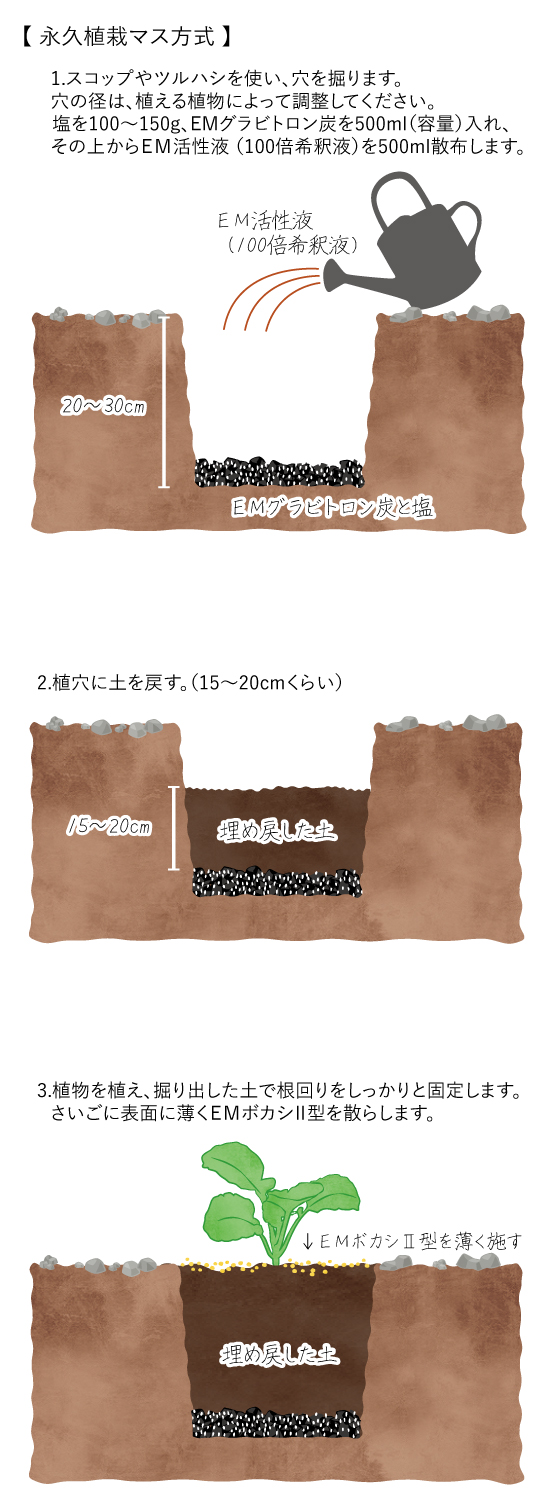
1. Dig a hole using a shovel or pickaxe. Adjust the diameter of the hole according to the plants to be planted. Add 100 to 150 g of salt, 500ml of EM Gravitron Charcoal, and apply 500ml of activated EM solution (1:100 diluted solution) on top.
2. Put soil back into the planting hole (to a depth of about 15 to 20 cm)
3. Plant the plant and fix the dug-out soil firmly around the roots. Finally, sprinkle a thin layer of EM Bokashi Type II on the surface.
A permanent planting mass can be made anywhere at any time, with the soil functioning like a Kekkai (boundary) under it. After the harvest is over, spread the residue around, apply 1-2 liters of activated EM seawater to the planting mass, leave it for a few days, thoroughly irrigating it, and then plant the next crop. As the number of permanent planting masses increases, the field’s Kekkai power also increases. At the same time, if we manage to constantly increase the level of EM DNA, the space will function to cleanse everything in the environment, and we will have the finest produce to enhance human health, and as much of it as we want.
2. Put soil back into the planting hole (to a depth of about 15 to 20 cm)
3. Plant the plant and fix the dug-out soil firmly around the roots. Finally, sprinkle a thin layer of EM Bokashi Type II on the surface.
A permanent planting mass can be made anywhere at any time, with the soil functioning like a Kekkai (boundary) under it. After the harvest is over, spread the residue around, apply 1-2 liters of activated EM seawater to the planting mass, leave it for a few days, thoroughly irrigating it, and then plant the next crop. As the number of permanent planting masses increases, the field’s Kekkai power also increases. At the same time, if we manage to constantly increase the level of EM DNA, the space will function to cleanse everything in the environment, and we will have the finest produce to enhance human health, and as much of it as we want.
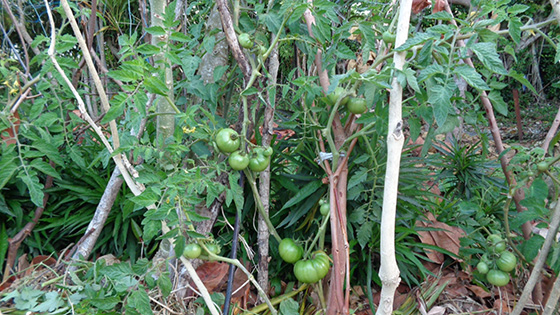
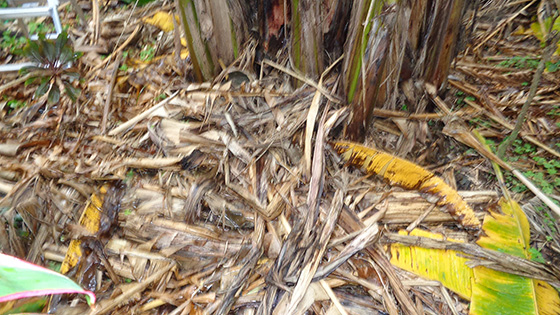
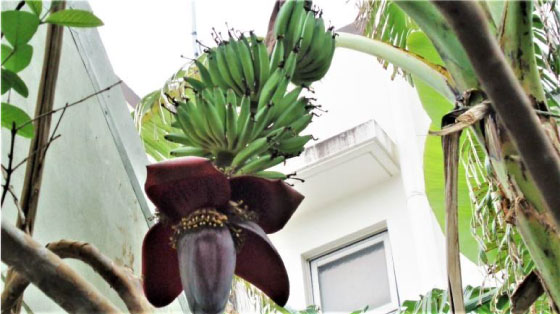
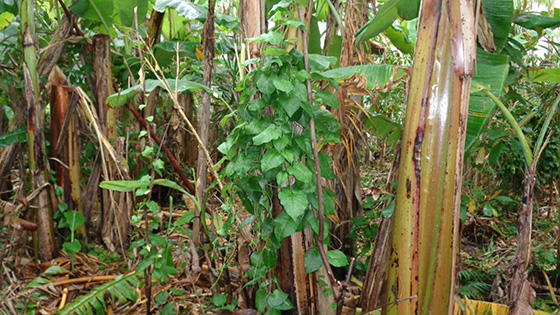
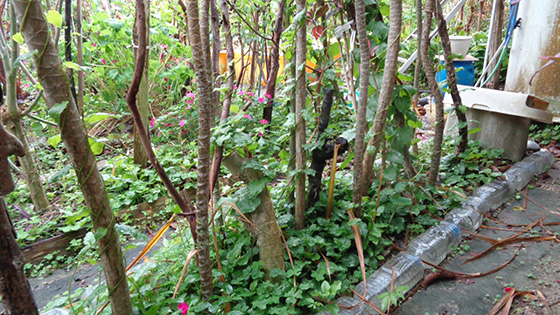
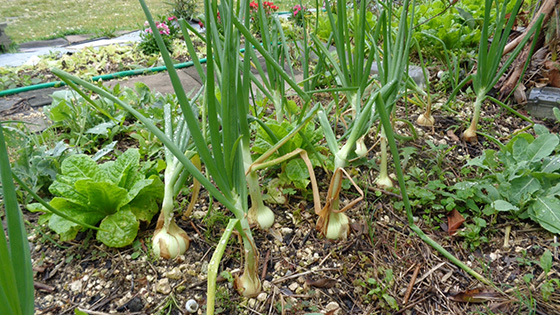
Birds and Flowers in Okinawa
In Okinawa, the period from February to March of the lunar calendar is called “Urizun”, a very pleasant season with an average temperature of around 20 degrees Celsius. Trees in the mountains are a brilliant green, and there are flower festivals and other events held in various parts of the prefecture, and flowers are in full bloom everywhere. This will be the second year I have presented news reports of flowers published in local newspapers, which I first introduced in the 158th edition of this magazine (March 2021). Year after year, newspapers are full of news about the vivid flowers in parks, the flowering trees, and trees along roadsides. I introduce these as a record of the post-EM Graviton boundary, Kekkai, in the Ryukyu Islands.
In Okinawa, the period from February to March of the lunar calendar is called “Urizun”, a very pleasant season with an average temperature of around 20 degrees Celsius. Trees in the mountains are a brilliant green, and there are flower festivals and other events held in various parts of the prefecture, and flowers are in full bloom everywhere. This will be the second year I have presented news reports of flowers published in local newspapers, which I first introduced in the 158th edition of this magazine (March 2021). Year after year, newspapers are full of news about the vivid flowers in parks, the flowering trees, and trees along roadsides. I introduce these as a record of the post-EM Graviton boundary, Kekkai, in the Ryukyu Islands.
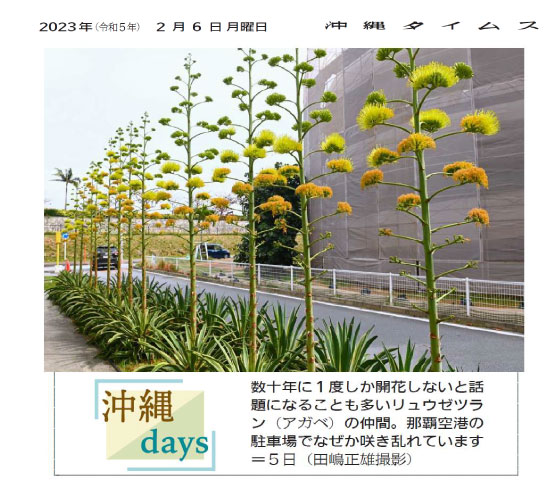
Okinawa Times, Monday, February 6, 2023
A member of the agave family that is often seen as blooming only once every decade or so, for some reason are in full bloom in the parking lot of Naha Airport-February, 5th (Photo by Masao Tajima)
A member of the agave family that is often seen as blooming only once every decade or so, for some reason are in full bloom in the parking lot of Naha Airport-February, 5th (Photo by Masao Tajima)
So beautiful! The Ryukyu Islands Archipelago: People and Nature #4

Okinawa Times, Wednesday, March 1,
Scarlet flowers coloring the Yoza-ga, the spring water channel in Itoman City
Yoza-ga in Itoman City has been a valuable source of water for the community. Brightly colored flowers of the Kaen Kazura, Flame Vine, brighten the shelves that cover the spring water channels. The flowers' blazing scarlet color makes it stand out against the surrounding greenery and blue sky. Taking advantage of the abundant water, the park has a children’s pool and staircase-style waterfall. The park retains its old-fashioned atmosphere and has become a place local residents go to relax. In summer, the park is crowded with children and their parents who come to cool off. The sound of the water flowing down the steps and the wind blowing in the breeze will help you forget the hustle and bustle of the city and return you to your childhood. (Photo by Masao Tajima)
Scarlet flowers coloring the Yoza-ga, the spring water channel in Itoman City
Yoza-ga in Itoman City has been a valuable source of water for the community. Brightly colored flowers of the Kaen Kazura, Flame Vine, brighten the shelves that cover the spring water channels. The flowers' blazing scarlet color makes it stand out against the surrounding greenery and blue sky. Taking advantage of the abundant water, the park has a children’s pool and staircase-style waterfall. The park retains its old-fashioned atmosphere and has become a place local residents go to relax. In summer, the park is crowded with children and their parents who come to cool off. The sound of the water flowing down the steps and the wind blowing in the breeze will help you forget the hustle and bustle of the city and return you to your childhood. (Photo by Masao Tajima)
The "somehow mysterious" identity of a young bird on the lake shore of a dam in Okinawa
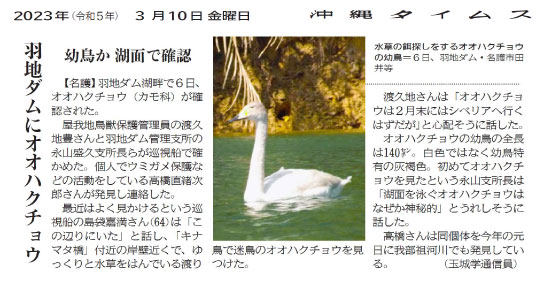
Okinawa Times, Friday, March 10, 2023
A whooper swan (duck family) was confirmed at the lakeside of Haneji Dam in Nago City, Okinawa Prefecture on March 6th. Yutaka Toguchi, a Yagaji Wildlife Conservation manager, and Morihisa Nagayama, director of the Haneji Dam Management Branch and others confirmed the sighting from a patrol boat. Naojiro Takahashi, who is personally engaged in activities such as protecting sea turtles, discovered the hooper swan and contacted them. Yoshimitsu Shimabukuro, 64, a member of the patrol boat who often sees the hooper swans these days, said, “It was around here,” and found a migratory whooper swan that was slowly foraging for water plants near the quay near the “Kinamata Bridge” Mr. Toguchi was concerned about the timing: “The whooper swans are supposed to leave for Siberia by the end of February,” he explained.The total length of the juvenile whooper swan is 140 centimeters. It is not white, but grayish brown, a color characteristic of juvenile swans. The branch director, Mr. Nagayama, who saw the whooper swan for the first time, happily said, “It's a bit mysterious to see a whooper swan swimming on the surface of the lake.” Mr. Takahashi also found the same bird on New Year’s Day of this year at the Gabusoka River. (Reported by Manabu Tamaki)
A whooper swan (duck family) was confirmed at the lakeside of Haneji Dam in Nago City, Okinawa Prefecture on March 6th. Yutaka Toguchi, a Yagaji Wildlife Conservation manager, and Morihisa Nagayama, director of the Haneji Dam Management Branch and others confirmed the sighting from a patrol boat. Naojiro Takahashi, who is personally engaged in activities such as protecting sea turtles, discovered the hooper swan and contacted them. Yoshimitsu Shimabukuro, 64, a member of the patrol boat who often sees the hooper swans these days, said, “It was around here,” and found a migratory whooper swan that was slowly foraging for water plants near the quay near the “Kinamata Bridge” Mr. Toguchi was concerned about the timing: “The whooper swans are supposed to leave for Siberia by the end of February,” he explained.The total length of the juvenile whooper swan is 140 centimeters. It is not white, but grayish brown, a color characteristic of juvenile swans. The branch director, Mr. Nagayama, who saw the whooper swan for the first time, happily said, “It's a bit mysterious to see a whooper swan swimming on the surface of the lake.” Mr. Takahashi also found the same bird on New Year’s Day of this year at the Gabusoka River. (Reported by Manabu Tamaki)
Jade vine shines fantastically at Okinawa World
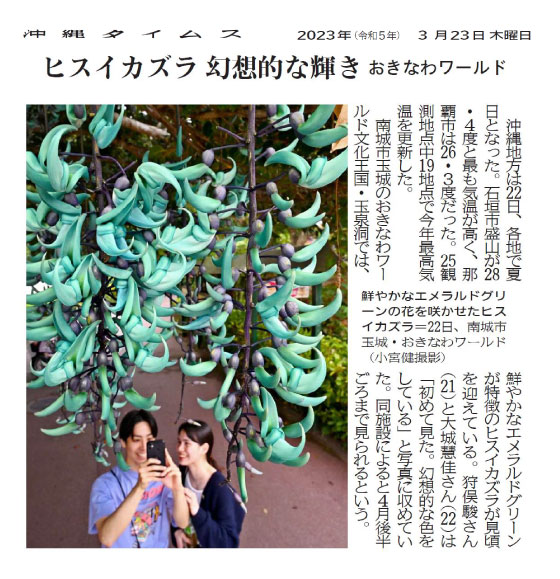
Okinawa Times, Thursday, March 23, 2023
On March 22nd, it was a summer day in various parts of Okinawa region. Moriyama in Ishigaki City had the hottest temperature at 28.4 degrees Celsius, while Naha City recorded 26.3 degrees Celsius. Nineteen of the twenty five observation sites recorded their highest temperatures of the year. The bright emerald green Jade vine at Gyokusendo in Okinawa World Culture Kingdom, located in Tamaki, Nango City, are in full bloom. Mr. Shun Karimata, 21, and Keika Oshiro, 22, said, as they took pictures, “This was the first time we've seen it. The color is fantastic." According to the facility, they can be seen until around the latter half of April.
On March 22nd, it was a summer day in various parts of Okinawa region. Moriyama in Ishigaki City had the hottest temperature at 28.4 degrees Celsius, while Naha City recorded 26.3 degrees Celsius. Nineteen of the twenty five observation sites recorded their highest temperatures of the year. The bright emerald green Jade vine at Gyokusendo in Okinawa World Culture Kingdom, located in Tamaki, Nango City, are in full bloom. Mr. Shun Karimata, 21, and Keika Oshiro, 22, said, as they took pictures, “This was the first time we've seen it. The color is fantastic." According to the facility, they can be seen until around the latter half of April.
How beautiful Ipe is! Blooming in Chuo, Okinawa City
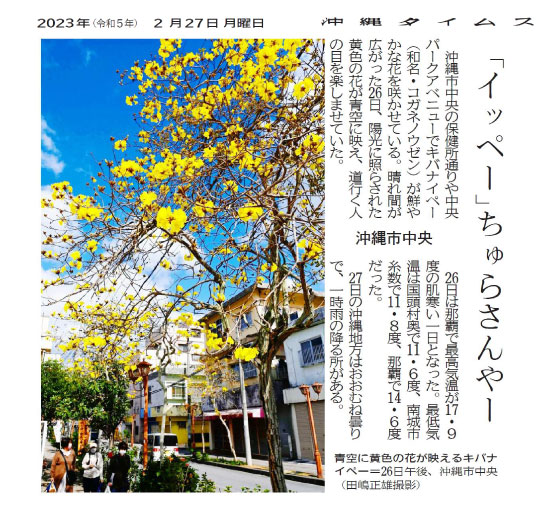
Okinawa Times, Monday, February 27, 2023
Yellow Ipe (Japanese name: Kogane nouzen) are blooming brightly on Health Center Street and Chuo Park Avenue in the central area of Okinawa City. On the 26th, when the weather cleared up, passers-by enjoyed the sight pf the yellow flowers shining in the sunlight against the blue sky. The 26th was a chilly day in Naha with a maximum temperature of 17.9 degrees Celsius. The lowest temperatures recorded on that day were 11.6 degrees in Kunigami Village Oku, 11.8 degrees in Itokazu, Nanjo City, and 14.6 degrees in Naha. The Okinawa region on the 27th is mostly cloudy, with occasional rain.
Yellow Ipe (Japanese name: Kogane nouzen) are blooming brightly on Health Center Street and Chuo Park Avenue in the central area of Okinawa City. On the 26th, when the weather cleared up, passers-by enjoyed the sight pf the yellow flowers shining in the sunlight against the blue sky. The 26th was a chilly day in Naha with a maximum temperature of 17.9 degrees Celsius. The lowest temperatures recorded on that day were 11.6 degrees in Kunigami Village Oku, 11.8 degrees in Itokazu, Nanjo City, and 14.6 degrees in Naha. The Okinawa region on the 27th is mostly cloudy, with occasional rain.
Warm spring weather, the best time to see the mayflowers. Over 20 degrees Celsius throughout the prefecture,
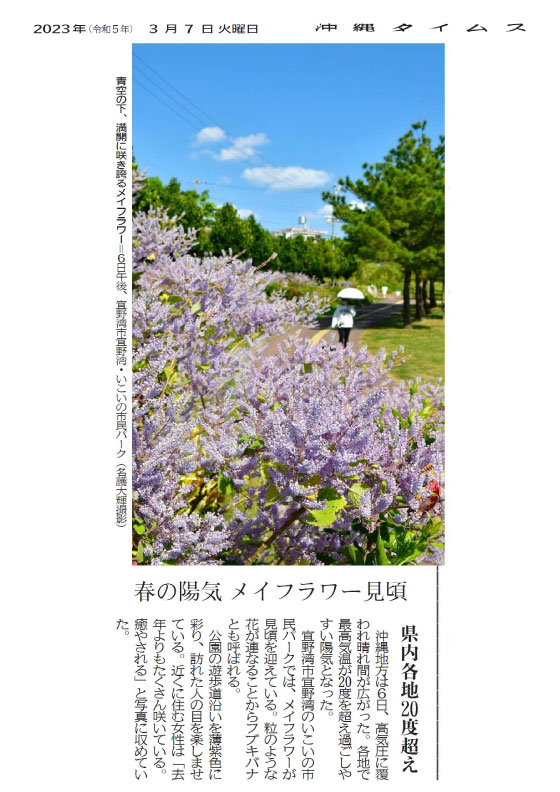
Okinawa Times, Tuesday, March 7, 2023
On March 6th, a high-pressure zone and clear skies covered the Okinawa region. The weather was pleasant, with high temperatures exceeding 20 degrees Celsius in various areas. May flowers are in full bloom at Ikoi no Shimin Park in Ginowan, Ginowan City. Another name for these is “fubuki-bana” because of the series of grain-like flowers. The light purple color along the promenade is a beautiful sight for visitors to the park. One woman who lives nearby took a picture of the flowers, commenting that, “There are lot more flowers than last year. It’s so relaxing and makes me happy.”
On March 6th, a high-pressure zone and clear skies covered the Okinawa region. The weather was pleasant, with high temperatures exceeding 20 degrees Celsius in various areas. May flowers are in full bloom at Ikoi no Shimin Park in Ginowan, Ginowan City. Another name for these is “fubuki-bana” because of the series of grain-like flowers. The light purple color along the promenade is a beautiful sight for visitors to the park. One woman who lives nearby took a picture of the flowers, commenting that, “There are lot more flowers than last year. It’s so relaxing and makes me happy.”
Ipe rosa brightly blooming - Signs of spring
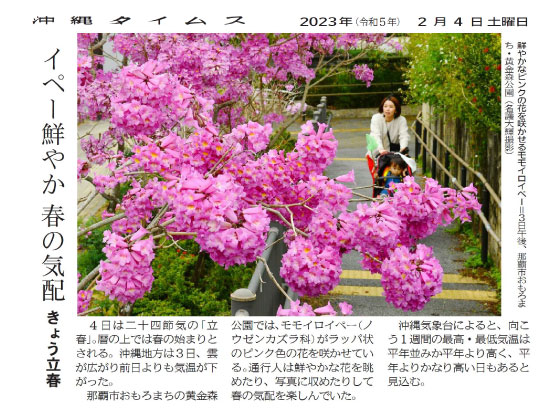
Okinawa Times, Saturday, February 4, 2023
Today is Risshun.
The 4th is the 24th solar term “Risshun”. According to the calendar, it marks the beginning of spring. On the 3rd, the Okinawa region grew cloudy and the temperature was lower than the previous day. At Koganemori Park in Omoromachi, Naha City, Ipe rosa (Bignoniaceae), trumpet-shaped pink flowers, were in full bloom. Passersby enjoyed the signs of spring by gazing at the bright pink flowers and taking pictures of them. According to the Okinawa Meteorological Observatory, the maximum and minimum temperatures for the next week are expected to be at or above normal, with some days much higher than normal.
Today is Risshun.
The 4th is the 24th solar term “Risshun”. According to the calendar, it marks the beginning of spring. On the 3rd, the Okinawa region grew cloudy and the temperature was lower than the previous day. At Koganemori Park in Omoromachi, Naha City, Ipe rosa (Bignoniaceae), trumpet-shaped pink flowers, were in full bloom. Passersby enjoyed the signs of spring by gazing at the bright pink flowers and taking pictures of them. According to the Okinawa Meteorological Observatory, the maximum and minimum temperatures for the next week are expected to be at or above normal, with some days much higher than normal.
50,000 azaleas are blooming in vivid color
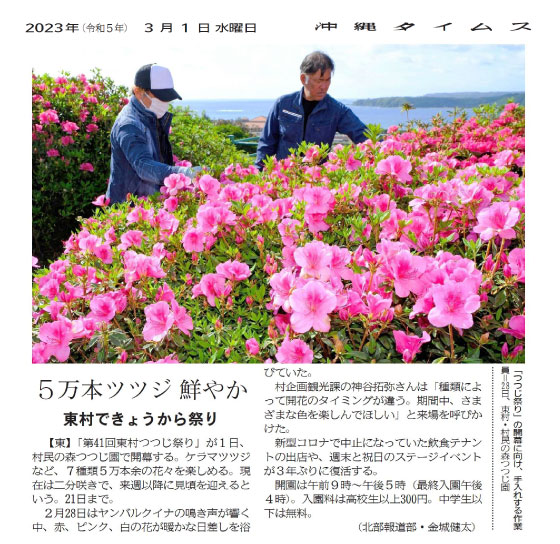
at the Azalea Garden in the Village People's Forest in Higashi Village on February 28th.
Okinawa Times, Wednesday, March 1, 2023
Festival starts on the 1st in Higashi Village, Okinawa.
The 41st Higashi Village Azalea Festival starts at the Azalea Garden in the Village People’s Forest on the 1st. Visitors can enjoy over 50,000 azaleas of seven varieties, including Kerama azalea. Currently, the flowers are in 20% in bloom and will be at their best from next week on ward until March 21. On February 28, the red, pink and white flowers were bathing in the warm sunshine, while Okinawa rails were chirping.
Mr. Takuya Kamiya of the Higashi Village Planning and Tourism Division said, “The timing of when they bloom differs according to the variety. I hope people will enjoy the various colors during the period of the festival,” he said. Food and beverage stands, which had been canceled due to the coronavirus, and stage events on weekends and holidays, will return for the first time in three years.
The park is open from 9:00 am to 5:00 pm (last entry at 4:00 pm). Admission fee is 300 yen for high school students and older. Admission is free for junior high school students and younger. (Kenta Kinjo, Northern Press Dept.)
Festival starts on the 1st in Higashi Village, Okinawa.
The 41st Higashi Village Azalea Festival starts at the Azalea Garden in the Village People’s Forest on the 1st. Visitors can enjoy over 50,000 azaleas of seven varieties, including Kerama azalea. Currently, the flowers are in 20% in bloom and will be at their best from next week on ward until March 21. On February 28, the red, pink and white flowers were bathing in the warm sunshine, while Okinawa rails were chirping.
Mr. Takuya Kamiya of the Higashi Village Planning and Tourism Division said, “The timing of when they bloom differs according to the variety. I hope people will enjoy the various colors during the period of the festival,” he said. Food and beverage stands, which had been canceled due to the coronavirus, and stage events on weekends and holidays, will return for the first time in three years.
The park is open from 9:00 am to 5:00 pm (last entry at 4:00 pm). Admission fee is 300 yen for high school students and older. Admission is free for junior high school students and younger. (Kenta Kinjo, Northern Press Dept.)
Bright Flame Vine flowers in bloom
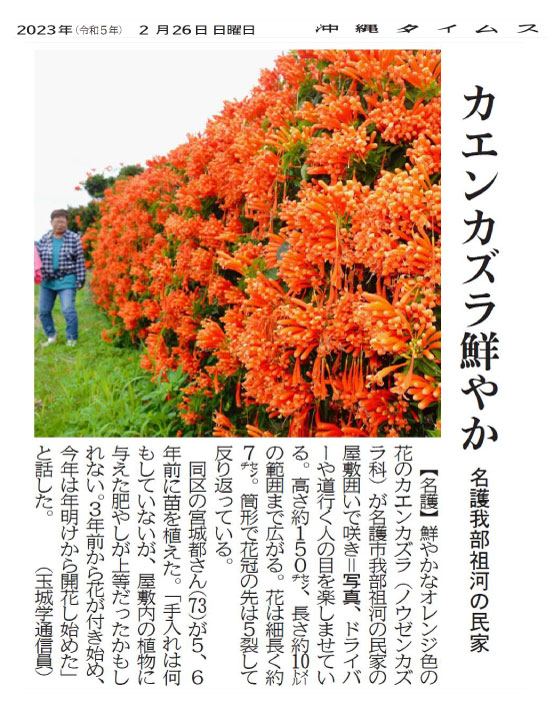
Okinawa Times,Thursday, February 26, 2023
At a private house in Gabusoka, Nago city
The bright orange flowers of the Flame vine (Bignoniaceae) are blossoming around the residence of a private house in Gabusoka, Nago City (See photo), delighting the eyes of drivers and passers-by. The vines are about 150 cm tall and spread to a length of about 10 meters. The flowers are long and slender, about 7 cm in length. The cylindrical corolla has five curved lobes at the tip.
Miyako Miyagi, 73, who lives in the same district, planted the seedlings six years ago. “I haven’t done any maintenance, but the fertilizer I gave to the plants in the house may have been excellent. Flowers started to appear three years ago, and this year they started blooming at the beginning of the year,” he said. (Reported by Manabu Tamaki)
At a private house in Gabusoka, Nago city
The bright orange flowers of the Flame vine (Bignoniaceae) are blossoming around the residence of a private house in Gabusoka, Nago City (See photo), delighting the eyes of drivers and passers-by. The vines are about 150 cm tall and spread to a length of about 10 meters. The flowers are long and slender, about 7 cm in length. The cylindrical corolla has five curved lobes at the tip.
Miyako Miyagi, 73, who lives in the same district, planted the seedlings six years ago. “I haven’t done any maintenance, but the fertilizer I gave to the plants in the house may have been excellent. Flowers started to appear three years ago, and this year they started blooming at the beginning of the year,” he said. (Reported by Manabu Tamaki)
(April 14th, 2023)
Editor’s Picks
-

#196 The Steadily Evolving EM Nature Farming Method at the Blue Sky Palace - Part 6 -

#195 The Steadily Evolving EM Nature Farming Method at the Blue Sky Palace - Part 5 -

#191 Steadily Evolving EM Nature Farming Method at the Blue Sky Palace -

#190 Quantum Mechanical Effects of EM Gravitron Charcoal
- 2025
- Sep:#209 The Widespread Use of EM in Ecuador
- Sep:#208 The Widespread Use of EM in Chile
- Jul:#207 Peru, where EM has taken root throughout the country
- May:#206 EM Application Technology in Paraguay Begins to Evolve into Advanced Circular Agriculture
- May:#205 Practical Application of Soil Disinfectant-Free Cultivation Using EM Technology
- Apr:#204 How EM Use Has Spread Throughout the Philippines
- Mar:#203 How to Use EM to Fundamentally Solve the Problem of Agricultural Residue Burning
- Feb:#202 The Spread of EM technology in Germany
- Jan:#201 The 2nd Ichiro Masaki Memorial Universal Village EM International Conference
- Jan:#200 Cleanup of the Ala Wai Canal in Hawaii, where social bonds are strengthened using EM
- 2024
- Nov:#199 EM trials in India with bananas, tomatoes, and pomegranates
- Oct:#198 The Steadily Evolving EM Nature Farming Method at the Blue Sky Palace - Part 8
- Sep:#197 The Steadily Evolving EM Nature Farming Method at the Blue Sky Palace - Part 7
- Aug:#196 The Steadily Evolving EM Nature Farming Method at the Blue Sky Palace - Part 6
- Jul:#195 The Steadily Evolving EM Nature Farming Method at the Blue Sky Palace - Part 5
- Jun:#194 Steadily Evolving EM Nature Farming Method at the Blue Sky Palace - Part 4
- May:#193 Steadily Evolving EM Nature Farming Method at the Blue Sky Palace - Part 3
- May:#192 Steadily Evolving EM Nature Farming Method at the Blue Sky Palace - Part 2
- Apr:#191 Steadily Evolving EM Nature Farming Method at the Blue Sky Palace
- Mar:#190 Quantum Mechanical Effects of EM Gravitron Charcoal
- Mar:#189 The barrier space in Okinawa (Ryukyu Islands) has risen to another dimension
- Jan:#188 Sixty Days after Typhoon No.6
- 2023
- Oct:#187 Supermassive Typhoon No.6 and Subsequent Typhoon No. 11
- Sep:#186 Massive Typhoon No.6 that swallowed the Ryukyu Islands Graviton barrier
- Sep:#185 August 8th is World “EM Mudball Day”
- Aug:#184 A disease-free life depends on the health of the intestinal microbiome.
- Jul:#183 Trial and Error at the Blue-Sky Palace, Part 3
- Jun:#182 Trial and Error at the Blue-Sky Palace, Part 2
- Apr:#181 Trial and Error at the Blue-Sky Palace
- Mar:#180 Ala Wai Canal Cleanup Project in Waikiki, Hawaii
- Feb:#179 High-Yield, High-Quality Rice Production Using EM
- Feb:#178 The Progress the "Soil Preparation Workshop" of the Oishi 3-chan Club (Part 2)
- Jan:#177 Organic Farming Instructional Manual Using EM
- 2022
- Nov:#176 The Typhoon Situation in Okinawa in 2022
- Sep:#175 Third-Party Verification of the Graviton barrier in Okinawa Part-2
- Sep:#174 Third-Party Verification of the Graviton barrier in Okinawa
- Aug:#173 Ecosystem Changes Observed in Okinawa in 2021 Part-5
- Jun:#172 Ecosystem Changes Observed in Okinawa in 2021 Part-4
- May:#171 Ecosystem Changes Observed in Okinawa in 2021 Part-3
- Apr:#170 Ecosystem Changes Observed in Okinawa in 2021 Part-2
- Mar:#169 Koizumi Farm in Kamakura Continues to Evolve
- Feb:#168 Ecosystem Changes Observed in Okinawa in 2021 Part-1
- 2021
- Dec:#167 Enjoying EM Technology While Enriching the Local Ecosystem
- Nov:#166 A Case Study of the Use of EM in a Next Generation Free School in Tune with the Cycles of Nature
- Oct:#165 Typhoon conditions and flowers in Okinawa from August to October
- Sep:#164 Re-learning the origins of river purification using EM Cleaning up the Dairyuji River in Senami (Murakami City, Niigata Prefecture)
- Aug:#163 Measures Against Natural Disasters and Re-learning the Starting Point of EM
- Jul:#162 Summary of FFC (Foods for Children) Okinawa Forum 2021
- Jun:#161 Restoring the Vigor of an Old Tree and Purifying the Environment with EM Technology That Even an Amateur Can Do
- May:#160 The Public is Beginning to Recognize the Use of EM Smokeless Carbonizers
- Apr:#159 EM Hado (EM Graviton) that exerts quantum superposition effect over time
- Mar:#158 Virus-free Okinawan Plants Through Use of an EM Graviton Barrier
- Jan:#157 Enjoyable Farming for Self-Sufficiency that Even Amateurs Can Do
- 2020
- Dec:#156 EM quantum energy effect occurring in Okinawa
- Nov:#155 Implementing EM graviton farming as a flood countermeasure for apple orchards
- Oct:#154 The Latest Book on the Practical Uses of EM "You Are the One Who Draws Out the Power of Microorganisms," by Chizuko Nomoto
- Sep:#153 Application of EM technology to long periods of rain, lack of sunshine, storms, heavy rains, etc.
- Aug:#152 EM application in Kitanakagusuku village plant waste recycling yard
- Jul:#151 Natural Disaster Countermeasures Using EM Technology: Part 2
- Jul:#150 Natural Disaster Countermeasures Using EM Technology
- May:#149 How to make your home and workplace an energy spot by living a complete EM lifestyle: creating the ultimate source of health and environmental purification
- Apr:#148 EM, Viruses and the Pandemic
- Apr:#147 New agriculture applying quantum mechanics Part 2
- Apr:#146 New agriculture applying quantum mechanics
- Apr:#145 Wonderful EM Miracle
- 2019
- Nov:#144 The movie “Revival II” and the reality of Fukushima
- Oct:#143 Boundary dome and foliar spraying of EM・X GOLD and EM 3
- Oct:#142 Kirakira (Sparkling) Summer Vegetable Festa in 2019
- Aug:#141 Excessive salt inevitably causes salt damage
- Jul:#140 Diverse applications of charcoal Part 3
- Jun:#139 Diverse applications of charcoal Part 2
- Jun:#138 Diverse applications of charcoal
- Jun:#137 Purification power of salt
- May:#136 The degree of soil contamination is a reflection of the microflora
- May:#135 Definitive use of EM barriers to deal with typhoons
- May:#134 Implementing authentic Nature Farming
- May:#133 How to enhance healthy Hado (wave energy) by EM
- May:#132 Eating Dirt (Soil)
- May:#131 Hado (Wave energy) involved in health
- May:#130 Reaffirming EM technology to realize the essence of agriculture
- May:#129 The 2nd EM Producer Networking Meeting
- Apr:#128 Understanding the application of seawater and salt in crop cultivation
- Apr:#127 Prevention of Disasters by EM Technology
- Mar:#126 Quantum overlay effective utilization of EM
- Jan:#125 EM Disaster Recovery Support Projects in 2017
- 2018
- 2017
- Aug:#121 Escape from conventional agricultural traps
- Jul:#120 Limitation and important caveats regarding utilization of salt
- Jun:#119 EM Technology to Break Through the Limits of Pesticide-Free Strawberries
- May:#118 Application of barriers using EM rectification force
- Apr:#117 The 1st EM Produce Growers' Networking Conference
- Mar:#116 Sumizo kun: The Ultimate Versatile Carbonization Equipment
- Feb:#115 How to make and use simple carbonized and rectified ash
- Jan:#114 Achievements of 2016
- 2016
- Dec:#113 Definitive Measures Against Typhoons
- Nov:#112 International Conference on Universal Village
- Oct:#111 90% of Your Body is Microbes
- Sep:#110 Disaster Countermeasures Using EM
- Aug:#109: Changes in the Natural Environment by EM Barrier Domes in Okinawa
- Jul:#108: Multi-purpose Utilization of Activated EM with Seawater and Salt
- Jun:#107: Marine Day, when EM Mudballs and Activated EM are Applied Throughout Japan
- May:#106: The Function of EM and Gravitational Waves–Part 3
- Apr:#105: The Function of EM and Gravitational Waves–Part 2
- Feb:#104: The Function of EM and Gravitational Waves
- Feb:#103: The Importance of Phototrophic Bacteria in EM
- 2015
- Dec:#102: Results of Environmental Forum "Utsukushima EM Paradise" 2015
- Nov:#101: Environmental Forum "Utsukushima EM Paradise" 2015
- Oct:#100: A New Phase of Limit Breakthrough Using EM
- Sep:#99: A New Phase of Limit Breakthrough through EM
- Aug:#98: The Tokyo Bay Area Began Creating a Truly Livable Hometown
- Jul:#97: Rectifying Effects of EM
- Jun:#96: Lake Suwa Sousei lecture
- May:#95: In Order to Further Ensure Limit Breakthrough
- Apr:#94: Theatrical Release of the Documentary Film SOSEI-Revival to Enlighten People on the New Possibilities of Microorganisms
- Mar:#93: What Underlies Limit Breakthrough (Part 2)
- Feb:#92: EM Functions to Break Through Limits
- Jan:#91: At the Start of 2015
- 2014
- Dec:#90: Looking Back at 2014
- Nov:#89: Shikoku EM FESTA 2014, Virtuous Circle Conference in Matsuyama, Ehime Prefecture
- Oct:#88: Using EM to Deal with Weather Disasters (Part 2)
- Sep:#87: Current Status of Radioactivity Measures Using EM in Fukushima
- Aug:#86: APNAN (Asia Pacific Natural Agriculture Network) 25th Anniversary Conference in 2014
- Jul:#85: Using EM to Deal with Weather Disasters
- Jun:#84: Substantial Improvement of Soil
- May:#83: The Energy Rectification Force of EM
- Apr:#82: The Annual 18th EM Technology Exchange Meeting and Tohoku Conference in Shichigahama
- Mar:#81: Salmon going upstream in Kitaura (Kasumigaura)
- Feb:#80: The Microbiome Again
- Jan:#79: Inauguration of the Federation of Diet Members Who Use and Apply Effective Microorganisms
- 2013
- Dec:#78: Receiving an Honorary Doctoral Degree from Rajamangala University of Technology in Thailand
- Nov:#77: The Use of EM in School Education in Bhutan
- Oct:#76: Well of Bonding
- Sep:#75: The Background to EM Not Being Employed by Public Institutions to Deal with Radiation
- Aug:#74: Dealing with Disaster: Using EM in Crisis Management
- Jul:#73: EM Events on Ocean Day
- Jun:#72: Using EM to Deal With Heat Stroke and Summer Heat Fatigue
- May:#71: An EM Model Town in Malaysia
- Apr:#70: Steps the Japanese Government is Taking to Deal with Radiation: Are They Really Safe?
- Mar:#69: EM Group Disaster Reconstruction Aid Project in Fukushima
- Feb:#68: EM and Microbiomes (Microbial Flora)
- Jan:#67: A Necessary Evil is Still Evil
- 2012
- Dec:#66: The 17th National EM Technology Exchange Conference / Hokkaido Conference in Sapporo
- Nov:#65: EM Forum 2012 in Okinawa and the Environmental Forum in Fukushima
- Oct:#64: 2012 EM Forum
- Sep:#63: A New Earth Saving Revolution
- Aug:#62: The Asahi Newspaper’s Misguided Reports About EM
- Jul:#61: Using EM in Radioactive Contamination Measures in Fukushima Prefecture
- Jun:#60: The Effects of Using EM to Inhibit the Absorption of Radioactivity as Confirmed in Fukushima
- May:#59: Recovery Support for the Great East Japan Earthquake
- Apr:#58: The Royal Kingdom of Thailand, in which EM Functions as a Set Government Policy
- Mar:#57: Report on the Measures Taken by Kingdom of Thailand Using EM to Deal with Polluted Water
- Feb:#56 EM™ as Part of National Policy in Thailand to Deal with Sanitation Issues Resulting from the Flood of 2011
- Jan:#55 The Law of Syntropy (Revitalization)
- 2011
- Dec:#54 EM Forum 2011
- Nov:#53 Shikoku EM Festa 2011- Zenjunkan no Wa (Virtuous Circle) Tokushima Conference in Naruto -
- Oct:#52 The Mystery of Interim Safety Values for Radioactive Material
- Sep:#51 Successful Radiation Countermeasures Using EM
- Aug:#50 Events on Sea Day in which EM Mud Balls are Thrown into the Water and Activated EM is Applied.
- May:#47 Dealing with the Damage Caused by the Eastern Japan Earthquake
- Apr:#46 Eastern Japan Earthquake
- Mar:#45 The 16th National EM Technology Hokuriku Conference in Fukui
- Feb:#44 More Thoughts on Avian Influenza and Foot-and-Mouth Disease
- Jan:#43 Happy New Year!
- 2010
- Dec:#42 Shikoku EM FESTA 2010・Zenjunkan no wa (Virtuous Circle) Fellowship Conference in Tobe, Ehime Prefecture
- Nov:#41 EM Forum 2010
- Oct:#40: My Thanks to the EM™ Volunteers Who Helped in the Fight Against Foot-and-Mouth Disease in Miyazaki Prefecture
- Sep:#39 International EM Mud Ball Day
- Jul:#37 Poland EM Forum 2010
- Jun:#36 EM Countermeasures Against Foot-and-Mouth Disease
- May:#35 Abnormal Weather
- Apr:#34 EM Activities in Thailand: Finding Solutions to the Challenges Facing the Nation
- Mar:#33 New Developments in the Evolution of EMTM in Thailand
- Feb:#32 Results Starting to Be Seen at the Mikasa Project
- Jan:#31 Towards an EM-Use Society
- 2009
- Dec:#30 EM Summit
- Nov:#29 The System in Penang State in Malaysia that Made the World EMTM Mudball Day a Success
- Oct:#28 The "World EM Mudball Day" in Malaysia
- Sep:#27 Validating EMTM Medicine: Case Study Reports from EM Users 2009. (Part 3)
- Sep:#26 Validating EMTM Medicine: Case Study Reports from EMTM Users 2009. (Part 2)
- Jul:#25 Validating EMTM Medicine: Case Study Reports from EMTM Users 2009. (Part 1)
- Jun:#24 Activities to Disseminate EM-Focused Nature Farming in China
- May:#23 Use of EMTM in Response to Swine Flu
- Apr:#22 Using EM to Solve Public Administrative Costs
- Mar:#21 Reaffirming the Versatility of EM
- Jan:#20 The Beginning of a New Era
- 2008
